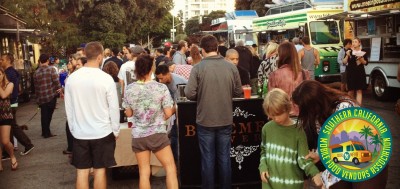How did food trucks become so popular in Los Angeles?
How did food trucks become so popular in Los Angeles? Is it the price? How about the food? The modern food truck industry seems to have come out of no where. One second there were traditional taco trucks the next second there’s Roy Choi and Kogi! How did the new trend become so popular so quickly? There are many facets to the answer.
The most common answer; Roy Choi launched Kogi in late 2008 just as the economy was slumping. During this time Twitter was exploding onto the nascent social media scene. Kogi used Twitter to connect with Los Angelenos. The cuisine was different but familiar to city residents who had grown up with both Mexican and Korean food. It was a perfect storm of cuisine, promotion and the public’s desire for deals. This answer ignores a few other variables.
So what lead to the huge surge in Los Angeles? In order for there to be a surge we needed the demand, but potential new vendors also needed food trucks. The economic downturn had a dramatic effect on the construction industry in Los Angeles County. The huge drop in construction projects meant a decline in the market for traditional taco trucks. Many of the trucks that had served construction sites went out of business once construction sites disappeared. Those food trucks were returned (or repossessed) to builders/lenders who were the original owners. The industry had a huge supply of permitted food trucks waiting to get rented to any aspiring entrepreneur with a dream. Our industry went from one food truck to ten to sixty in 18 months. So this addresses how the industry was able to grow so quickly. Now on to the why….
Why are people so enamored with food trucks? In 2010 The first Los Angeles Street Food Fest expected 4000 people. 18000 people showed up and 6000 were turned away. People came to wait in line to get into a festival where they waited in line to eat at a food truck. It was simply an amazing spectacle. City officials, some restaurant owners and many bloggers didn’t really grasp the draw. From my perspective, the draw was a combination of three variables.
Eating at a food truck is a social activity. While waiting in line or for an order customers feel very comfortable interacting with each other. Most of the time it’s to talk about the food. The community in Los Angeles, a traditionally car-centric community, has very few opportunities to interact with one another in public spaces. Once three or more food trucks occupy a block, the normally unused sidewalk becomes an organic public space. Eating great food and socializing is nice way to spend the lunch hour. People leave the experience full from the food and happy about the social interaction.
The innovative cuisine has been a huge draw. The restaurant industry has a high barrier to entry for most fledgling entrepreneurs. The high cost of opening a restaurant requires most people to seek loans or investments. Moneyed interests can sometimes put a damper on a chef’s innovative ideas. Imagine asking an investment group for $500,000- $1,000,000 pitching the Korean taco concept pre Kogi. It would have been a tough sell and I can imagine that most investors would rather go with a proven cuisine. The desire to limit risk in food service can slow innovation. However, with the lower cost of entry into the market food trucks can take wild chances and introduce cuisines not normally found in their respective marketplace. Grilled cheese sandwiches, Korean tacos, Chinese mexican fusion, Indian street food were all some of the first cuisines to hit the streets in LA. There were little if any counterparts in brick and mortar restaurants. The new cuisines were exciting to a public looking for something different.
A food trucks’ lower operating costs means they can provide high quality ingredients at a lower cost. As a lunchtime option, trucks are typically more expensive than fast food but cheaper than a mid range sit down meal. The quick nature of service lends itself to a lunchtime crowd looking for quick food at reasonable prices.
So how did food trucks become so popular? It’s combination of innovative food, reasonable prices, and a welcome social experience. The food truck industry is expected to continue its meteoric climb. It’s important that the food truck industry continue to offer the food and experiences that have made it so popular. As the industry grows in popularity, more and more communities will embrace the trend.



Leave a Reply